Python - Introduction to List | 12th Computer Science : Chapter 9 : Python Modularity and OOPS : Lists, Tuples, Sets And Dictionary
Chapter: 12th Computer Science : Chapter 9 : Python Modularity and OOPS : Lists, Tuples, Sets And Dictionary
Introduction to List
Introduction to List
Python programming language has four
collections of data types such as List, Tuples, Set and Dictionary. A list in
Python is known as a “sequence data
type” like strings. It is an ordered collection of values enclosed within
square brackets [ ]. Each value of a list is called as element. It can be of
any type such as numbers, characters, strings and even the nested lists as
well. The elements can be modified or mutable which means the elements can be
replaced, added or removed. Every element rests at some position in the list.
The position of an element is indexed with numbers beginning with zero which is
used to locate and access a particular element. Thus, lists are similar to
arrays, what you learnt in XI std.
1. Create a List in Python
In python, a list is simply created by using
square bracket. The elements of list should be specified within square
brackets. The following syntax explains the creation of list.
Syntax:
Variable = [element-1, element-2, element-3 ……
element-n]
Example
Marks = [10, 23, 41, 75]
Fruits = [“Apple”, “Orange”,
“Mango”, “Banana”]
MyList = [ ]
In the above example, the list Marks has four
integer elements; second list Fruits has four string elements; third is an
empty list. The elements of a list need not be homogenous type of data. The
following list contains multiple type elements.
Mylist = [ “Welcome”, 3.14, 10, [2, 4, 6] ]
In the above example, Mylist contains another
list as an element. This type of list is known as “Nested List”.
Nested list is a list containing another list
as an element.
2. Accessing List elements
Python assigns an automatic index value for
each element of a list begins with zero. Index value can be used to access an
element in a list. In python, index value is an integer number which can be
positive or negative.
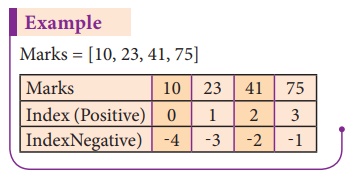
Positive value of index counts from the
beginning of the list and negative value means counting backward from end of
the list (i.e. in reverse order).
To access an element from a list, write the
name of the list, followed by the index of the element enclosed within square
brackets.
Syntax:
List_Variable = [E1, E2, E3 …… En]
print (List_Variable[index of a element])
Example
(Accessing single element):
>>>Marks = [10, 23, 41, 75]
>>>print (Marks[0])
10
In the above example, print command prints 10
as output, as the index of 10 is zero.
Example: Accessing elements in revevrse order
>>>Marks = [10, 23, 41, 75]
>>>print (Marks[-1])
75
Note: A negative index can be used to access an
element in reverse order.
(i) Accessing all elements of a list
Loops are used to access all elements from a
list. The initial value of the loop must be zero. Zero is the beginning index
value of a list.
Example
Marks = [10, 23, 41, 75]
i = 0
while i < 4:
print (Marks[i])
i = i + 1
Output
10
23
41
75
In the above example, Marks list contains four
integer elements i.e., 10, 23, 41, 75. Each element has an index value from 0.
The index value of the elements are 0, 1, 2, 3 respectively. Here, the while
loop is used to read all the elements. The initial value of the loop is zero,
and the test condition is i < 4, as long as the test condition is true, the
loop executes and prints the corresponding output.
During the first iteration, the value of i is zero, where the condition is true. Now, the following statement print (Marks [i]) gets executed and
prints the value of Marks [0] element ie. 10.
The next statement i = i + 1 increments the value of i from 0 to 1. Now, the flow of control shifts to
the while statement for checking the test condition. The process repeats to
print the remaining elements of Marks
list until the test condition of while loop becomes false.
The following table shows that the execution of loop and the value
to be print.
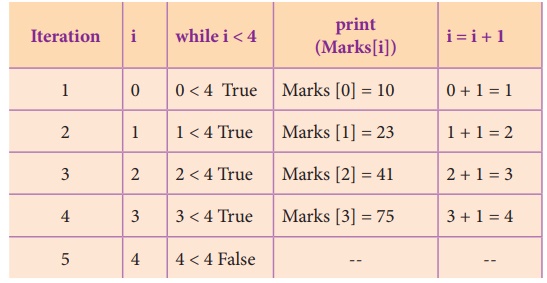
(ii) Reverse Indexing
Python enables reverse or negative indexing for
the list elements. Thus, python lists index in opposite order. The python sets
-1 as the index value for the last element in list and -2 for the preceding
element and so on. This is called as Reverse
Indexing.
Example
Marks = [10, 23, 41, 75]
i = -1
while i >= -4:
print (Marks[i])
i = i + -1
Output
75
41
23
10
The following table shows the working process
of the above python coding
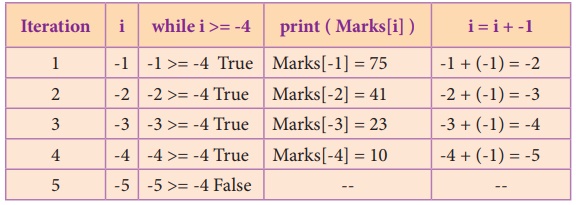
3. List Length
The len( ) function in Python is used to find
the length of a list. (i.e., the number of elements in a list). Usually, the
len( ) function is used to set the upper limit in a loop to read all the
elements of a list. If a list contains another list as an element, len( )
returns that inner list as a single element.
Example :Accessing single element
>>>MySubject = [“Tamil”,
“English”, “Comp. Science”, “Maths”]
>>>len(MySubject)
4
Example : Program to display elements in a list using
loop
MySubject = ["Tamil",
"English", "Comp. Science", "Maths"] i = 0
while i < len(MySubject):
print (MySubject[i])
i = i + 1
Output
Tamil
English
Comp. Science
Maths
4. Accessing elements using for loop
In Python, the for loop is used to
access all the elements in a list one by one. This is just like the for
keyword in other programming language such as C++.
Syntax:
for index_var in list:
print (index_var)
Here, index_var represents the index value
of each element in the list. Python reads this “for” statement like English: “For (every) element in (the list of) list
and print (the name of the) list
items”
Example
Marks=[23, 45, 67, 78, 98]
for x in Marks:
print( x )
Output
23
45
67
78
98
In the above example, Marks list has 5
elements; each element is indexed from 0 to 4. The Python reads the for
loop and print statements like English: “For (every) element (represented as x) in (the list of) Marks and print (the values of the) elements”.
5. Changing list elements
In Python, the lists are mutable, which means
they can be changed. A list element or range of elements can be changed or
altered by using simple assignment operator (=).
Syntax:
List_Variable [index of an element] = Value to be
changed
List_Variable [index from : index to] = Values to
changed
Where, index from is the beginning index of
the range; index to is the upper limit of the range which is excluded in
the range. For example, if you set the range [0:5] means, Python takes only 0
to 4 as element index. Thus, if you want to update the range of elements from 1
to 4, it should be specified as [1:5].
Python program to update/change single value
MyList = [2, 4, 5, 8, 10]
print ("MyList elements
before update... ")
for x in MyList:
print (x)
MyList[2] = 6
print ("MyList elements
after updation... ")
for y in MyList:
print (y)
Output:
MyList elements before update...
2
4
5
8
10
MyList elements after updation..
2
4
6
8
10
Python program to update/change range of values
MyList = [1, 3, 5, 7, 9]
print ("List Odd numbers...
")
for x in MyList:
print (x)
MyList[0:5] = 2,4,6,8,10
print ("List Even numbers...
")
for y in MyList:
print (y)
Output
List Odd numbers...
1
3
5
7
9
List Even numbers...
2
4
6
8
10
6. Adding more elements in a list
In Python, append( ) function is used to add a
single element and extend( ) function is used to add more than one element to
an existing list.
Syntax:
List.append (element to be added)
List.extend ( [elements to be added])
In extend( ) function, multiple elements should
be specified within square bracket as arguments of the function.
Example
>>>Mylist=[34, 45, 48]
>>>Mylist.append(90)
>>>print(Mylist)
[34, 45, 48, 90]
In the above example, Mylist is created with
three elements. Through >>>
Mylist.append(90) statement, an additional value 90 is included with the existing list as last element,
following print statement shows all the elements within the list MyList.
Example
>>>Mylist.extend([71,
32, 29])
>>>print(Mylist)
[34, 45, 48, 90, 71, 32, 29]
In the above code, extend( ) function is used
to include multiple elements, the print statement shows all the elements of the
list after the inclusion of additional elements.
7. Inserting elements in a list
As you learnt already, append( ) function in
Python is used to add more elements in a list. But, it includes elements at the
end of a list. If you want to include an element at your desired position, you
can use insert ( ) function. The insert( ) function is used to insert an
element at any position of a list.
Syntax:
List.insert (position index, element)
Example
>>>MyList=[34,98,47,'Kannan',
'Gowrisankar', 'Lenin', 'Sreenivasan' ]
>>>print(MyList)
[34, 98, 47, 'Kannan',
'Gowrisankar', 'Lenin', 'Sreenivasan']
>>>MyList.insert(3,
'Ramakrishnan')
>>>print(MyList)
[34, 98, 47, 'Ramakrishnan',
'Kannan', 'Gowrisankar', 'Lenin', 'Sreenivasan']
In the above example, insert( ) function
inserts a new element ‘Ramakrishnan’ at the index value 3, ie. at the 4th
position. While inserting a new element in between the existing elements, at a
particular location, the existing elements shifts one position to the right.
8. Deleting elements from a list
There are two ways to delete an element from a
list viz. del statement and remove( ) function. del statement is
used to delete known elements whereas remove( ) function is used to delete
elements of a list if its index is unknown. The del statement can also be used
to delete entire list.
Syntax:
del List [index of an element]
#to delete a particular element
del List [index from : index to]
#to delete multiple elements
del List
#to delete entire list
Example
>>>MySubjects =
['Tamil', 'Hindi', 'Telugu', 'Maths']
>>>print (MySubjects)
['Tamil', 'Hindi', 'Telugu',
'Maths']
>>>del MySubjects[1]
>>>print (MySubjects)
['Tamil', 'Telugu', 'Maths']
In the above example, the list MySubjects has been created with four
elements. print statement shows all the elements of the list. In >>> del MySubjects[1]
statement, deletes an element whose index value is 1 and the following print
shows the remaining elements of the list.
Example
>>>del MySubjects[1:3]
>>>print(MySubjects)
['Tamil']
In the above codes, >>> del MySubjects[1:3] deletes the second and third
elements from the list. The upper limit of index is specified within square
brackets, will be taken as -1 by the python.
Example
>>>del MySubjects
>>>print(MySubjects)
Traceback (most recent call last):
File
"<pyshell#9>", line 1, in <module> print(MySubjects)
NameError: name 'MySubjects' is
not defined
Here, >>> del MySubjects, deletes the
list MySubjects entirely. When you try to print the elements, Python shows an
error as the list is not defined. Which means, the list MySubjects has been
completely deleted.
As already stated, the remove( ) function can
also be used to delete one or more elements if the index value is not known.
Apart from remove( ) function, pop( ) function can also be used to delete an
element using the given index value. pop( ) function deletes and returns the
last element of a list if the index is not given.
The function clear( ) is used to delete all the
elements in list, it deletes only the elements and retains the list. Remember that,
the del statement deletes entire list.
Syntax:
List.remove(element) # to delete a particular element
List.pop(index of an element)
List.clear( )
Example
>>>MyList=[12,89,34,'Kannan',
'Gowrisankar', 'Lenin']
>>>print(MyList)
[12, 89, 34, 'Kannan', 'Gowrisankar',
'Lenin']
>>>MyList.remove(89)
>>>print(MyList)
[12, 34, 'Kannan', 'Gowrisankar',
'Lenin']
In the above example, MyList has been created
with three integer and three string elements, the following print statement
shows all the elements available in the list. In the statement >>> MyList.remove(89), deletes
the element 89 from the list and the print statement shows the remaining
elements.
Example
>>>MyList.pop(1)
34
>>>print(MyList)
[12, 'Kannan', 'Gowrisankar',
'Lenin']
In the above code, pop( ) function is used to
delete a particular element using its index value, as soon as the element is
deleted, the pop( ) function shows the element which is deleted. pop( )
function is used to delete only one element from a list. Remember that, del
statement deletes multiple elements.
Example
>>>MyList.clear( )
>>>print(MyList)
[ ]
In the above code, clear( ) function removes
only the elements and retains the list. When you try to print the list which is
already cleared, an empty square bracket is displayed without any elements,
which means the list is empty.
9. List and range ( ) function
The range( ) is a function used to generate a
series of values in Python. Using range( ) function, you can create list with
series of values. The range( ) function has three arguments.
Syntax of range ( ) function:
range (start value, end value, step value)
where,
start value – beginning value of series. Zero is the
default beginning value.
end value – upper limit of series. Python takes the
ending value as upper limit – 1.
step value – It is an optional argument, which is used to generate different
interval of values.
Example : Generating whole numbers upto 10
for x in range (1, 11):
print(x)
Output
1
2
3
4
5
6
7
8
9
10
Example : Generating first 10 even numbers
for x in range (2, 11, 2):
print(x)
Output
2
4
6
8
10
(i) Creating a list with series of values
Using the range( ) function, you can create a
list with series of values. To convert the result of range( ) function into
list, we need one more function called list( ). The list( ) function makes the result of
range( ) as a list.
Syntax:
List_Varibale = list ( range ( ) )
Note
The list ( ) function is all so used to create
list in python.
Example
>>>Even_List =
list(range(2,11,2))
>>>print(Even_List)
[2, 4, 6, 8, 10]
In the above code, list( ) function takes the
result of range( ) as Even_List elements. Thus, Even_List list has the elements
of first five even numbers.
Similarly, we can create any series of values
using range( ) function. The following example explains how to create a list
with squares of first 10 natural numbers.
Example : Generating squares of first 10 natural
numbers
squares = [ ]
for x in range(1,11):
s = x ** 2
squares.append(s)
print (squares)
In the above program, an empty list is created
named “squares”. Then, the for loop generates natural numbers from 1 to 10
using range( ) function. Inside the loop, the current value of x is raised to
the power 2 and stored in the variables. Each new value of square is appended
to the list “squares”. Finally, the program shows the following values as
output.
Output
[1, 4, 9, 16, 25, 36, 49, 64, 81, 100]
10. List comprehensions
List comprehension is a simplest way of
creating sequence of elements that satisfy a certain condition.
Syntax:
List = [ expression for variable in range ]
Example : Generating squares of first 10 natural
numbers using the concept of List comprehension
>>>squares = [ x ** 2
for x in range(1,11) ]
>>>print (squares)
Output:
[1, 4, 9, 16, 25, 36, 49, 64, 81,
100]
In the above example, x ** 2 in the expression
is evaluated each time it is iterated. This is the shortcut method of
generating series of values.
11. Other important list function
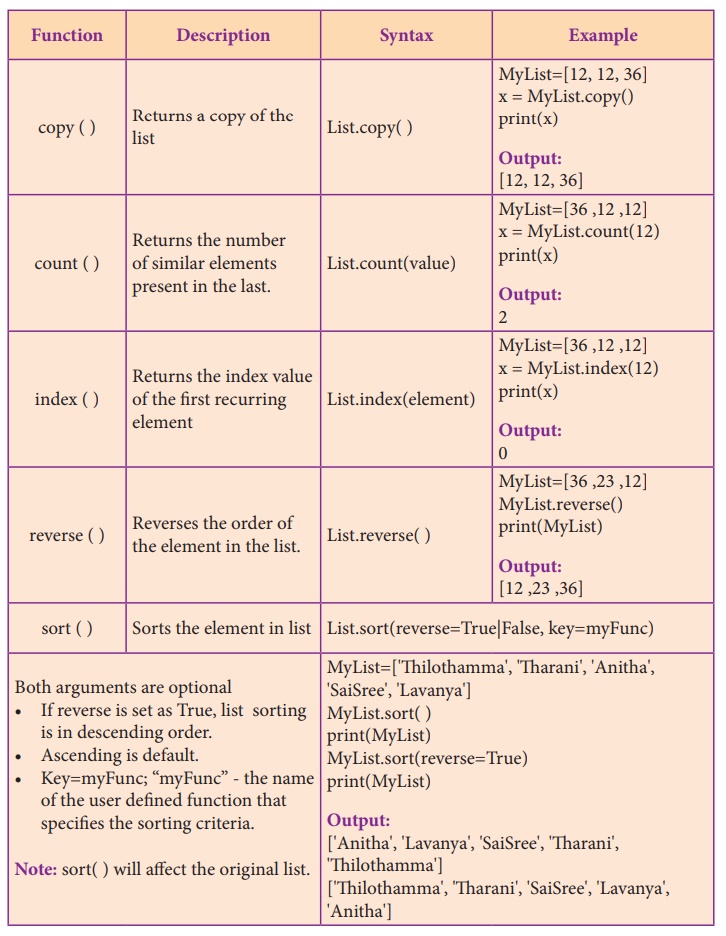
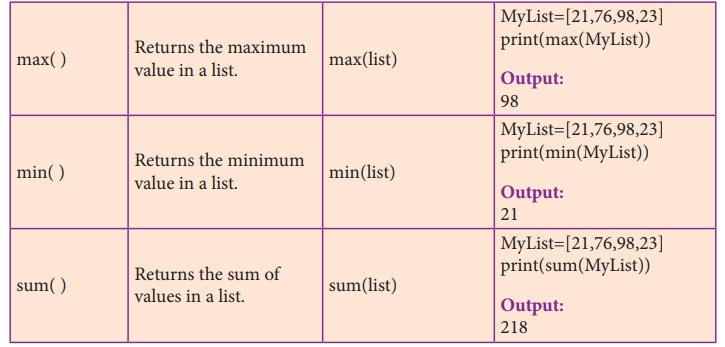
12. Programs using List
Program 1: write a program that creates a list of
numbers from 1 to 20 that are divisible by 4
divBy4=[ ]
for i in range(21):
if (i%4==0):
divBy4.append(i)
print(divBy4)
Output
[0, 4, 8, 12, 16, 20]
Program 2: Write a program to define a list of
countries that are a member of BRICS. Check whether a county is member of BRICS
or not
country=["India",
"Russia", "Srilanka", "China",
"Brazil"]
is_member = input("Enter the
name of the country: ")
if is_member in country:
print(is_member, " is the
member of BRICS")
else:
print(is_member, " is not a
member of BRICS")
Output
Enter the name of the country:
India
India is the member of BRICS
Output
Enter the name of the country:
Japan
Japan is not a member of BRICS
Program 3: Python program to read marks of six
subjects and to print the marks scored in each subject and show the total marks
marks=[]
subjects=['Tamil', 'English',
'Physics', 'Chemistry', 'Comp. Science', 'Maths'] for i in range(6):
m=int(input("Enter Mark =
"))
marks.append(m)
for j in range(len(marks)):
print("{ }. { } Mark = { }
".format(j1+,subjects[j],marks[j]))
print("Total Marks = ",
sum(marks))
Output
Enter Mark = 45
Enter Mark = 98
Enter Mark = 76
Enter Mark = 28
Enter Mark = 46
Enter Mark = 15
1. Tamil Mark = 45
2. English Mark = 98
3. Physics Mark = 76
4. Chemistry Mark = 28
5. Comp. Science Mark = 46
6. Maths Mark = 15
Total Marks = 308
Program 4: Python program to read prices of 5 items
in a list and then display sum of all the prices, product of all the prices and
find the average
items=[]
prod=1
for i in range(5):
print ("Enter price for item
{ } : ".format(i+1))
p=int(input())
items.append(p)
for j in range(len(items)):
print("Price for item { } =
Rs. { }".format(j+1,items[j]))
prod = prod * items[j]
print("Sum of all prices =
Rs.", sum(items))
print("Product of all prices
= Rs.", prod)
print("Average of all prices
= Rs.",sum(items)/len(items))
Output:
Enter price for item 1 :
5
Enter price for item 2 :
10
Enter price for item 3 :
15
Enter price for item 4 :
20
Enter price for item 5 :
25
Price for item 1 = Rs. 5
Price for item 2 = Rs. 10
Price for item 3 = Rs. 15
Price for item 4 = Rs. 20
Price for item 5 = Rs. 25
Sum of all prices = Rs. 75
Product of all prices = Rs.
375000
Average of all prices = Rs. 15.0
Program 5: Python program to count the number of
employees earning more than 1 lakh per annum. The monthly salaries of n number
of employees are given
count=0
n=int(input("Enter no. of
employees: "))
print("No. of
Employees",n)
salary=[]
for i in range(n):
print("Enter Monthly Salary
of Employee { } Rs.: ".format(i+1))
s=int(input())
salary.append(s)
for j in range(len(salary)):
annual_salary = salary[j] * 12
print ("Annual Salary of
Employee { } is:Rs. { }".format(j+1,annual_salary))
if annual_salary >= 100000:
count = count + 1
print("{ } Employees out of
{ } employees are earning more than Rs. 1 Lakh per annum".
format(count, n))
Output:
Enter no. of employees: 5
No. of Employees 5
Enter Monthly Salary of Employee
1 Rs.:
3000
Enter Monthly Salary of Employee
2 Rs.:
9500
Enter Monthly Salary of Employee
3 Rs.:
12500
Enter Monthly Salary of Employee
4 Rs.:
5750
Enter Monthly Salary of Employee
5 Rs.:
8000
Annual Salary of Employee 1
is:Rs. 36000
Annual Salary of Employee 2
is:Rs. 114000
Annual Salary of Employee 3
is:Rs. 150000
Annual Salary of Employee 4
is:Rs. 69000
Annual Salary of Employee 5
is:Rs. 96000
2 Employees out of 5 employees
are earning more than Rs. 1 Lakh per annum
Program 6: Write a program to create a list of
numbers in the range 1 to 10. Then delete all the even numbers from the list
and print the final list.
Num = []
for x in range(1,11):
Num.append(x)
print("The list of numbers
from 1 to 10 = ", Num)
for index, i in enumerate(Num):
if(i%2==0):
del Num[index]
print("The list after
deleting even numbers = ", Num)
Output
The list of numbers from 1 to 10
= [1, 2, 3, 4, 5, 6, 7, 8, 9, 10] The list after deleting even numbers = [1, 3,
5, 7, 9]
Program 7: Write a program to generate in the
Fibonacci series and store it in a list. Then find the sum of all values.
a=-1
b=1
n=int(input("Enter no. of
terms: "))
i=0
sum=0
Fibo=[]
while i<n:
s = a + b
Fibo.append(s)
sum+=s
a = b
b = s
i+=1
print("Fibonacci series upto
"+ str(n) +" terms is : " + str(Fibo))
print("The sum of Fibonacci
series: ",sum)
Output
Enter no. of terms: 10
Fibonacci series upto 10 terms is
: [0, 1, 1, 2, 3, 5, 8, 13, 21, 34]
The sum of Fibonacci series: 88
Related Topics